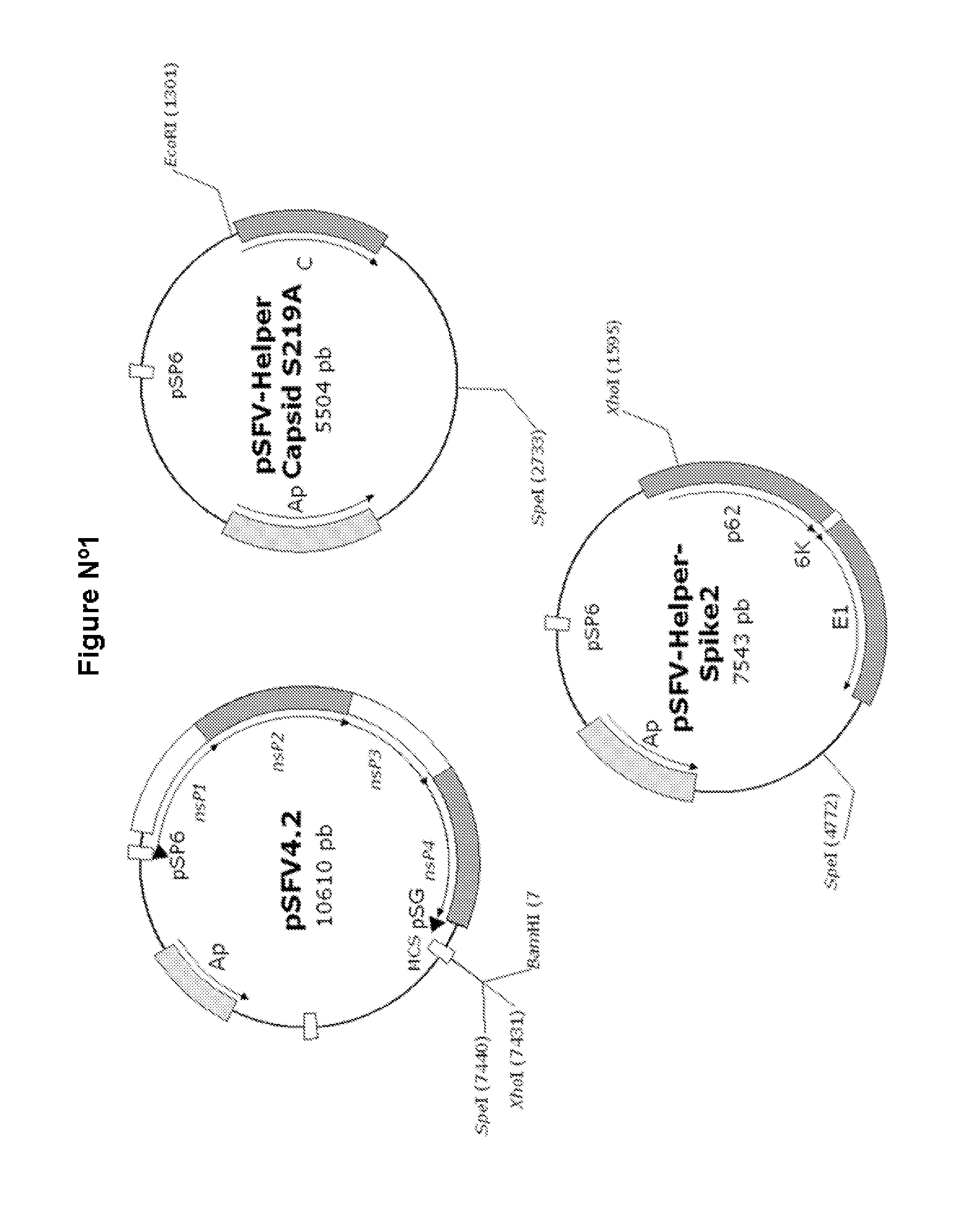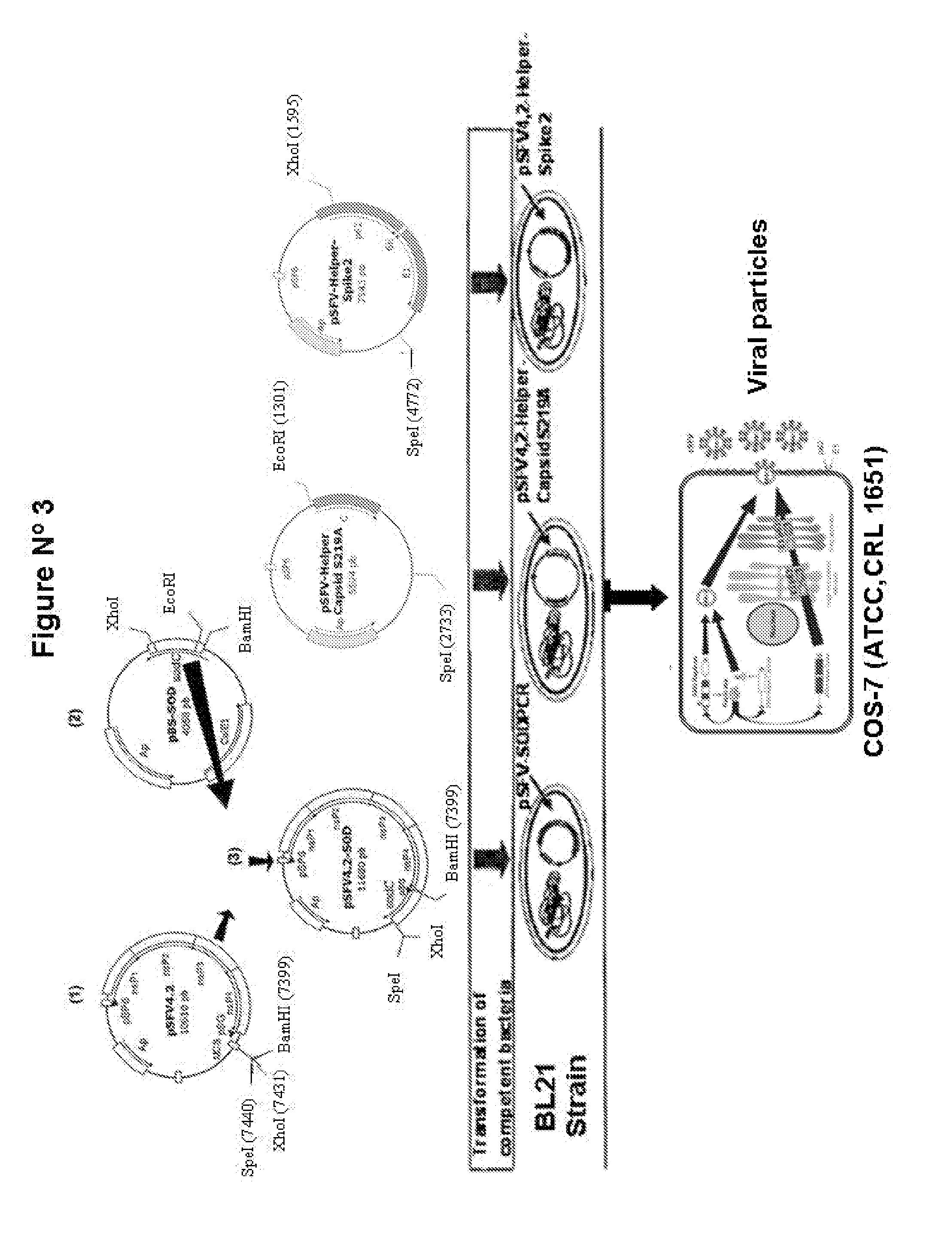Veterinary pharmaceutical formulacion that comprises an RNA recombinant particle that encodes for a cu/zn superoxide dismutase protein of ruminant pathogenic bacteria and at least one RNA alphavirus belonging to the semliki forest virus family
a technology of rna and recombinant particles, which is applied in the field of veterinary pharmaceutical formulas, can solve the problems of not being able to protect i>brucella from patent application, affecting serological diagnosis, and not being able to work with sod protein in patent applications, so as to achieve high protection, protection efficacy, and high protection
- Summary
- Abstract
- Description
- Claims
- Application Information
AI Technical Summary
Benefits of technology
Problems solved by technology
Method used
Image
Examples
example 1
Extraction of Total Proteins from the Strain RB51 of Brucella abortus
[0088]The procedure for the extraction of bacteria included their culture. Once harvested, they were washed three times with sterile PBS at a pH of 7.2, centrifuged at 10000 rpm for 10 minutes at 4° C., eliminating the supernatant. The bacteria were inactivated in methanol at 60% for 24 hours. Subsequently the cells were washed again and kept for 24 hours at 4° C. in a hypertonic saline solution that contained NaCl (1 M), 0.1 sodium citrate and EDTA (0.5 mM). Then the cells were sonicated for approximately 15 minutes at 60 watts, and centrifuged at 10000 rpm for 10 minutes at 4° C. 0.2 mM of phenylmethylsulfonyl fluoride (PMSF) were added to the supernatant and the proteins were concentrated with polyethylenglycol in dialysis bags with a molecular weight retention capacity above 3500 kD. Then the fraction concentrated in this way was dialyzed against distilled water for two days, at the end of which it was centrif...
example 2
Expression of the Recombinant Cu / Zn Superoxide Dismutase Protein (see FIG. 6)
[0089]The Cu / Zn SOD protein of Brucella abortus was expressed in E. coli DH5 bacteria that were transformed by electroporation with the plasmid pBSSOD that contains the gene that encodes the Cu / Zn SOD protein (sodC). To obtain the protein the bacterium was cultured in LB broth plus 100 μg / ml of ampicillin for 12 hours at 37° C., with agitation. Subsequently the bacteria were collected from the culture broth and centrifuged at 3000 rpm for 20 minutes. The bacteria were re-suspended in 10 mM phosphate buffer at pH 7.6 plus 0.1% of Triton X-100 and were incubated at 37° C. for 12 hours, with agitation. The mixture was centrifuged at 10000 rpm for 20 minutes, and the recovered supernatant was then added to a column of anionic exchange, which has no affinity for the Cu / Zn SOD protein, most of the other proteins present in the supernatant being retained. The eluate obtained from the column was treated with polymi...
example 3
Construction of the Plasmid
[0090]Once the original gene of the Cu—Zn superoxide dismutase protein (SodC) had been obtained using restriction enzymes from the plasmid pUC19, the plasmid pSFV4.2-SOD was constructed. For this purpose, the plasmid PUC19 was subjected to digestion with the enzymes BamHI and XhoI for 2 hours at 37° C. From the digestion a fragment of 1.1 kb was obtained that contained the gene of interest, which was extracted from 1% agarose gel using a commercial kit. (see FIG. 4, Line 2). In addition, the plasmid pSFV4.2 was digested with the same restriction enzymes used previously and in the same conditions. At the end of incubation, the restriction enzymes were inactivated at 60° C. for 15 minutes. Subsequently, ligation was carried out, mixing in a proportion of 3:1 the 1.1 kb insert with the plasmid pSFV4.2, which presented a marker for the ampicillin antibiotic. This was previously digested using the ligase enzyme DNA T4 in ligase buffer DNA T4 10× plus 5 mM of AT...
PUM
| Property | Measurement | Unit |
|---|---|---|
| concentration | aaaaa | aaaaa |
| concentration | aaaaa | aaaaa |
| pH | aaaaa | aaaaa |
Abstract
Description
Claims
Application Information
 Login to View More
Login to View More - R&D
- Intellectual Property
- Life Sciences
- Materials
- Tech Scout
- Unparalleled Data Quality
- Higher Quality Content
- 60% Fewer Hallucinations
Browse by: Latest US Patents, China's latest patents, Technical Efficacy Thesaurus, Application Domain, Technology Topic, Popular Technical Reports.
© 2025 PatSnap. All rights reserved.Legal|Privacy policy|Modern Slavery Act Transparency Statement|Sitemap|About US| Contact US: help@patsnap.com



